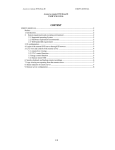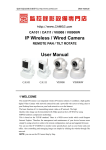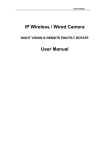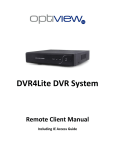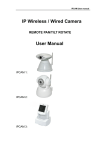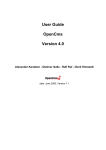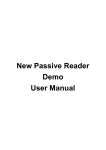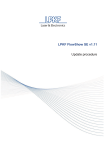Download IE_User`s Manual - B-sec
Transcript
Access to remote DVR from IE USER’S MANUAL Access to remote DVR from IE USER’S MANUAL CONTENT USER’S MANUAL .......................................................................................................................... 2 Preface ....................................................................................................................................... 2 1. Introduction ........................................................................................................................... 2 2. System requirement and executing environment ............................................................... 2 2.1. Supported operating System: ..................................................................................... 2 2.2. Hardware requirement (recommend): ........................................................................ 2 2.3. Web bandwidth requirement: ..................................................................................... 2 3. IE configuration .................................................................................................................... 2 4. Login to the remote DVR server through IE browser ........................................................... 3 5. Live view and control of the remote server ........................................................................... 4 5.1. remote live viewing .................................................................................................... 5 5.2. P.T.Z. control function ................................................................................................ 5 5.3 image control function ................................................................................................ 5 5.4. Picture local saved path and record local saved path ................................................. 6 5.5. Remote client OSD .................................................................................................... 6 6. Search, playback and backup remote recordings .................................................................. 6 6.1. Searching and downloading recordings ..................................................................... 6 6.2. playback recordings ................................................................................................... 7 7. Alarm event monitoring ........................................................................................................ 8 8. About ..................................................................................................................................... 9 9. Logout ................................................................................................................................... 9 1 / 10 Access to remote DVR from IE USER’S MANUAL Access to remote DVR from IE USER’S MANUAL Preface You can access to remote DVR with remote surveillance without a client software installed. Our DVR supports web control. The main function of IE control is to view the remote live, playback and backup remote recordings, view and export remote server’s logs, etc. This manual will help you to familiarize with the IE controller and master its operation methods. Notice: A. As product update, the contents of this manual are subject to change without notice. B. Some part functions and symbols may not be completely same with what you get due to the continuous revision of this software. 1. Introduction To use web controller you have to use IE connect to DVR to download and install the ActiceX controls for remote controlling the DVR. The IE controller designed for embedded digital video recorder to realize remote surveillance management. In the video surveillance system, the administrator can control PTZ, etc through configuring parameters, viewing the live site to achieve the purpose of live site surveillance, video record and record file backup and so on. It possesses three main functions: preview the live site, system configuration and video search. DVR supports multi-users logging in and operating the network client synchronously. 2. System requirement and executing environment 2.1. Supported operating System: Windows 2000/2003/XP/vista(Need Microsoft .NET Framework 4.0 or later version installed); windows 7; 2.2. Hardware requirement (recommend): CPU: Intel Core 2 Duo 2.4 or above. Memory: 2GB or above. Graphics card: independent 128M graphics card or above. Network card: 10/100/1000M. 2.3. Web bandwidth requirement: To obtain smoother A/V playing effect, the minimum web bandwidth requirement is: Main stream connection needs 333 Kbps/channel at least; Secondary stream connection needs 44 Kbps/channel at least. 3. IE configuration You have to configure the safety certificate of your IE browser before connect to the remote DVR. 2 / 10 Access to remote DVR from IE USER’S MANUAL Operation steps: (1) Double-click the IE browser icon to open the IE browser. (2) Select “tools > Internet Options” in the menu bar to pop up “internet options” window. (3) Click “security” tab, then click “custom level…” in “security level for this zone” to open “security settings” window. (4) Enable the options which relate with ActiveX controls under the “security settings” window. (5) Click “ok” button. Figure 3 4. Login to the remote DVR server through IE browser (1) Input IP/domain of the DVR in IE textbox, then press “enter” button. (2) Install ActiveX controls automatically. (3) After the ActiveX controls installed the login window will be display in the IE browser. (4) Input the user name, password and control port then click on the “login” button to access to remote DVR. 3 / 10 Access to remote DVR from IE USER’S MANUAL Figure 4 5. Live view and control of the remote server 8 9 10 7 1 11 12 13 14 15 18 2 3 4 16 5 17 19 6 Figure 5 4 / 10 Access to remote DVR from IE USER’S MANUAL 5.1. remote live viewing icon to connect to live (1) Camera list – camera list of the remote server. Click the view of a camera with default stream (Main Stream). Click the icon to connect to live view of a camera with Main Stream/Extra Stream. (2) Open All –start/stop live view of the remote cameras in the list. (3) Start Dialog – to activate/deactivate tow way real-time talk communication with the connected remote DVR. (4) Local Play – playback local saved video files. (5) Refresh – refresh the camera list. (6) Screen layout - Switch from 1, 4, 9, 16, 36 etc. channel views. Simply click on your selected layout to change the layout. (7) Screen – live view screen. (8) INFO – display the information of device IP, camera number and live bit stream. (9) Operation of the live view. (9.1) Digital zoom - Click this button and then left drag the mouse in the live screen to zoom in your drag zone. Right click live screen to restore original image. (9.2) Change show mode - switch to full screen mode. (9.3) Local record - To manually start recording live stream, the recording video will be saved in the path of video local folder. (9.4) Capture picture - To capture an image of the display screen, the image will be saved in the path of local folder. (9.5) Audio – Turn on/off audio. (9.6) Close Video – Disconnect live view of the remote camera. 5.2. P.T.Z. control function (10) Pan/Tilt buttons – Pans/Tilts camera (11) Pan/Tilt Speed – Adjusts pan/tilt speed (12) Zoom Control – Zooms In/Zooms Out (13) Focus Control – Adjusts focus (14) Iris Control – Adjusts amount of light entering the camera (15) Advanced P.T.Z operation 5.3 image control function (16) Via Image Control (Color tab), you can change brightness, contrast, saturation and hue or to increase or decrease settings of the cameras currently displayed. Simply click on the selected image control option on the cameras currently displayed. Click the Reset button to return settings to the factory default settings for all cameras. 5 / 10 Access to remote DVR from IE USER’S MANUAL Figure 5.3 5.4. Picture local saved path and record local saved path (17) Click More tab to setup the local storage path of the capture pictures and recordings. Click Reboot to restart the remote device. Figure 5.4 5.5. Remote client OSD (18) Time – displays the current date and time of the DVR Server the Remote Client is connected to. (19) Channel name– Indicates camera label/channel name. 6. Search, playback and backup remote recordings 6.1. Searching and downloading recordings 1 2 3 4 5 7 6 Figure 6.1 (1) SEARCH button – click SEARCH button to popup search widows. 6 / 10 Access to remote DVR from IE USER’S MANUAL (2) Type – recording type selector. Select a recording type you want to search/playback. Record - general recordings. Alarm - alarm recordings. Local – local saved recordings. (3) Parameter – select start time, end time and channel you want to search/playback. (4) Operation (4.1) Search – start searching. (4.2) Playback – playback the recording you want to search. (4.3) Download – download the recordings storage in remote device into local storage device. (4.4) Open local record. (5) Recordings list – list the recordings according to your searching results. (6) Prev/Next Page – turn to previous/next page of the recording list. (7) Download Rate – indicate the file download processing. 6.2. playback recordings Click Playback button or Open Local Record button to enter recordings playback windows. 2 1 3 4 5 Figure 6.2 (1) Playback screen – display the remote server recordings. (2) Operation of the playback screen. - Click this button and then left drag the mouse in the live screen to (2.1) Digital zoom zoom in your drag zone. Right click live screen to restore original image. (2.2) Change show mode - switch to full screen mode. (2.3) Local record - To manually start recording live stream, the recording video will be saved in the path of video local folder. (2.4) Capture picture - To capture an image of the display screen, the image will be saved in the path of local folder. 7 / 10 Access to remote DVR from IE USER’S MANUAL (2.5) Audio – Turn on/off audio. (2.6) Close Video – Disconnect live view of the remote camera. (3) Screen layout - Switch from 1, 4, 9, 16, 36 etc. channel views. Simply click on your selected layout to change the layout. (4) Playback processing bar – indicates the percentage of the playing back recording of the remote server. Click on the slide button to move the playback processing. (5) Playback operation - start playback remote/local recording. (5.1) Play - start/pause playback remote/local recording. (5.2) Pause - stop playback. (6) Stop – slow forward, decrease the playback speed. Support video playback in 1/2,1/4 (7) SF and 1/8 speed switch in turn. - slow forward, increase the playback speed. Support video playback in 1/8, 1/4, (8) FF 1/2, normal, 2, 4 and 8 speed up switch in turn. 7. Alarm event monitoring 1 3 4 2 5 Figure 7 (1) ALARM – click alarm button to enter Alarm windows. (2) Event type – select the alarm event type to monitor. Event type include video loss, motion detect, disk full, disk error, external alarm and video mask. (3) Operation – operations when alarm events occur. Listen Alarm – web will notify user when alarm occur. Video Pop-up – popup the video monitor when alarm occur. Prompt – popup the notification box when alarm occur. (4) Alarm Sound – enable/disable playing notification sound. (5) Event list – list all alarm event you monitoring. 8 / 10 Access to remote DVR from IE USER’S MANUAL 8. About Click about button to display the version information of the web controller. 9. Logout Click logout button to logout from the remote device and return to login windows. 9 / 10 Access to remote DVR from IE USER’S MANUAL 10 / 10










